
|
The "70 weeks" prophecy of Daniel 9 is one of the most remarkable prophecies in all of Scripture, as it unassailably identifies the precise years of the Saviour's baptism and crucifixion. Sadly, many either grossly misinterpret1 this great prophecy or overlook its larger implications. A close examination of Daniel's "70 weeks" irrefutably disproves a "Friday Crucifixion" and the notion that the modern 7-day week has cycled continuously without interruption since Creation! |
In the 9th chapter of Daniel, we find the prophet making a very emotional appeal to Yahuwah on behalf of Jerusalem and the exiled children of Israel, for he had recently received a very alarming vision (Daniel 8), the meaning of which he did not entirely understand. As Daniel is praying, the angel Gabriel appears to him and begins explaining in much detail the timing of the events that would precede the prophetic cleansing of the sanctuary2. It is this explanation that makes incontrovertibly clear the precise years of Yahushua's baptism and crucifixion. Gabriel begins by telling Daniel:
|
Seventy weeks are determined for your people and for your holy city, to finish the transgression, to make an end of sins, to make reconciliation for iniquity, to bring in everlasting righteousness, to seal up vision and prophecy, and to anoint the Most Holy. (Daniel 9:24) |
Here, Heaven makes clear that 70 prophetic weeks had been determined for Daniel's people (the Jews) and for the holy city (Jerusalem) in which the following was to be accomplished:
Before moving forward, it imperative that we understand the value of a prophetic week. When studying prophecy, we must always allow the Bible to interpret itself. Yahuwah has provided in His word the explanation for every symbol employed by the prophets. In Scripture, one prophetic day = one literal year.
. . . I have laid on you a day for each year. (Ezekiel 4:6)
After the number of the days in which you searched the land, even forty days, each day for a year, shall you bear your iniquities . . . (See Numbers 14:34.)
From this, we must conclude the following:
Now, let us continue to the next verse of the prophecy. In verse 25, Gabriel begins explaining in great detail the nature and timing of the events that were to transpire during the 70 prophetic weeks. Yahuwah's messenger, here, begins by giving the starting point and the ending point for the first 69 prophetic weeks of the count.
|
Know therefore and understand, that from the going forth of the command to restore and build Jerusalem until Messiah the Prince, there shall be seven weeks and sixty-two weeks; the street shall be built again, and the wall, even in troublesome times. (Daniel 9:25) |
Here, we learn that from the "command to restore and build Jerusalem" until the coming of the Messiah would be 69 prophetic weeks (7 weeks + 62 weeks). This is the equivalent of 483 literal years.
There are four events which can be taken as answering to "the command to restore and build Jerusalem." These are:
Three of these four decrees we can immediately dismiss.
The decree of Cyrus in 536 BC and the decree of Darius in 519 BC must be dismissed from the outset because counting 483 years from either of these decrees will fall short of the coming of the Messiah which was the specified ending point of the first 69 prophetic weeks. Counting 69 prophetic weeks from the decree of Cyrus would bring us to 53 BC. Counting from the decree of Darius would bring us to 36 BC. Again, both fall short and must be dismissed.
The third commission that we can dismiss is that which was given to Nehemiah by Artaxerxes in 444 BC. While the king did allow Nehemiah to return to Jerusalem, there appears to be no official decree. Artaxerxes simply granted Nehemiah's personal request to return to Jerusalem for a specified time. When Nehemiah arrived at Jerusalem, he found the people already engaged in the work of building the city. They were apparently acting under the decree given to Ezra thirteen years earlier. Nehemiah finished the work he wished to accomplish in Jerusalem after only fifty-two days (Nehemiah 6:15).
This makes clear which decree was to be the starting point for the 70 prophetic weeks, the first 69 of which were to extend to the coming of the Messiah: The decree given by Artaxerxes to Ezra in 457 BC.3
Artaxerxes, king of kings, unto Ezra the priest, a scribe of the law of the [Eloah] of heaven, perfect peace, and at such a time. I make a decree, that all they of the people of Israel, and of his priests and Levites, in my realm, which are minded of their own freewill to go up to Jerusalem, go with thee. (See Ezra 7:12-13.)
Now, that we have established with certainty when the 70 prophetic weeks commenced, let us count forward 69 weeks (483 years) to see if this takes us to the time of the Messiah as the angel had prophesied.
Counting forward 483 years from 457 BC brings us to 27 AD.
-457 + 483 = 26 AD
However, we must add one year because there is no year 0.
26 AD + 1 Year = 27 AD
What happened in 27 AD? Yahushua, the Messiah, was baptized! "The Most Holy" was anointed (Daniel 9:24) at the precise time specified by Gabriel.
That word, I say, you know . . . after the baptism which John preached; How Yahuwah anointed Yahushua of Nazareth with the Holy Spirit and with power. . . (See Acts 10:37-38.)
Yahushua knew well that the first 69 weeks of Daniel's prophecy had been fulfilled at His baptism, for it was after this that He began calling men to repentance, saying "the time is fulfilled, and the kingdom of Yahuwah is at hand." (Mark 1:15)
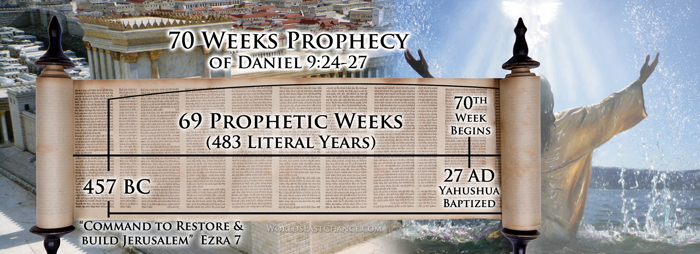
We can be certain that 27 AD was the year of Yahushua's baptism because Luke tells us that it took place in the fifteenth year of the reign of Tiberius Caesar.
Now in the fifteenth year of the reign of Tiberius Caesar . . . (Luke 3:1)
Now when all the people were baptized, it came to pass, that Yahushua also being baptized, and praying, the heaven was opened, and the Holy Ghost descended in a bodily shape like a dove upon Him, and a voice came from heaven, which said, Thou art my beloved Son; in thee I am well pleased. (See Luke 3:21-22.)
Tiberius began to reign officially as co-regent in 12 AD and as Emperor in 14 AD.4 Counting fifteen years from 12 AD, the first year of Tiberius' rule, brings us to 27 AD. This is in perfect harmony with what the angel had revealed to Daniel about 600 years earlier!
Recall also the angel's words regarding the city of Jerusalem itself:
|
. . . the street shall be built again, and the wall, even in troublesome times. (Daniel 9:25) |
The walls of Jerusalem were rebuilt during the first seven prophetic weeks (49 literal years) following Artaxerxes decree in 457 B.C. Truly, these were "troublesome times." Nehemiah tells us that, because of the incessant threat of attack, the workers "loaded themselves so that with one hand they worked at construction, and with the other held a weapon." (Nehemiah 4:17) In 408 BC, the restoration of Jerusalem and the temple was completed.
-457 + 49 = -408 (408 BC)

Amazing! The prophecy, however, does not stop there. Let us continue now to the next verse.
|
And after the sixty-two weeks Messiah shall be cut off, but not for Himself; And the people of the prince who is to come shall destroy the city and the sanctuary. The end of it shall be with a flood, And till the end of the war desolations are determined. (Daniel 9:26) |
Here, we are told that sometime after the 69 prophetic weeks had been fulfilled, the Messiah would be "cut off" and then the city would be destroyed. Continuing on to the final verse in the prophecy, Gabriel sheds light on the details of the 70th prophetic week:
|
Then He shall confirm a covenant with many for one week; But in the middle of the week He shall bring an end to sacrifice and offering. And on the wing of abominations shall be one who makes desolate, even until the consummation, which is determined, is poured out on the desolate. (Daniel 9:27) |
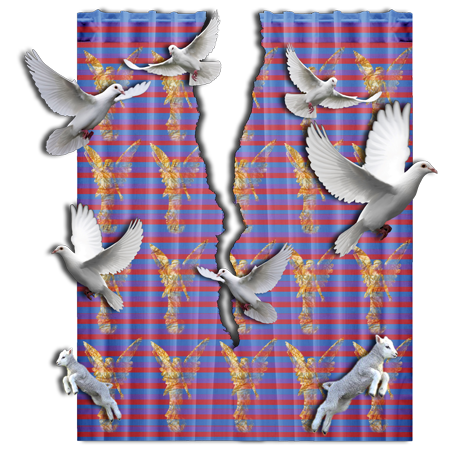 Here, the angel says that for the duration of the 70th prophetic week, He (the Messiah) would confirm a covenant with many. He then goes on to say that the Messiah would cause the sacrifices and oblation to cease in the middle of this final prophetic week.
Here, the angel says that for the duration of the 70th prophetic week, He (the Messiah) would confirm a covenant with many. He then goes on to say that the Messiah would cause the sacrifices and oblation to cease in the middle of this final prophetic week.
Let us first examine what took place in the middle of the 70th week. Counting forward 7 years (one prophetic week) from Yahushua's baptism in the autumn of 27 AD takes us to the autumn of 34 AD. This would place the middle of the 70th week in the spring of 31 AD. What occurred in the spring of 31 AD that caused the sacrifices and oblation to cease? The Messiah was crucified at the time of the Passover, and the veil of the temple in which the sacrifices were performed was rent by Yahuwah Himself from top to bottom!
And Yahushua cried out again with a loud voice, and yielded up His spirit. Then, behold, the veil of the temple was torn in two from top to bottom; and the earth quaked, and the rocks were split. (See Matthew 27:50-51.)
Yahushua, our Messiah, was the ultimate sin offering to which all of the animal sacrifices prescribed in the law pointed. He was "cut off, but not for Himself" (Daniel 9:26); He was crucified, not for what He had done, but for what you and I have done.
For He made Him who knew no sin to be sin for us, that we might become the righteousness of Yahuwah in Him. (See 2 Corinthians 5:21.)
Following His Crucifixion, the temple sacrifices were to forever cease.
For it is not possible that the blood of bulls and goats could take away sins. Therefore, when He [Yahushua, the Messiah] came into the world, He said: "Sacrifice and offering You did not desire, but a body You have prepared for Me. In burnt offerings and sacrifices for sin You had no pleasure. Then I said, 'Behold, I have come-- In the volume of the book it is written of Me-- To do Your will, O Yahuwah.' " . . . He takes away the first that He may establish the second. By that will we have been sanctified through the offering of the body of Yahushua the Anointed once for all. (See Hebrews 10:4-10.)
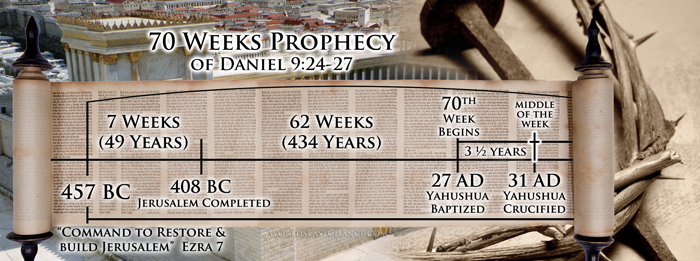
We know now with certainty that Yahushua was crucified in 31 AD, but Gabriel said that the Messiah was to "confirm a covenant with many for one week" (the duration of the 70th week which terminated in the autumn of 34 AD). How is this possible? The New Covenant that Yahushua the Messiah preached throughout His 3 1/2 year ministry was carried forward by the apostles following His crucifixion! The invitation to accept the New Covenant was extended to the Jewish nation until the autumn of 34 AD, when in a final act of rebellion against Heaven, the Sanhedrin murdered Stephen, the first Christian martyr (Acts 7). After delivering a remarkably powerful speech to the Sanhedrin, making clear the guilt of the Jewish nation in refusing Yahuwah's prophets and rejecting the Messiah, Stephen was taken by the council and stoned.
The divine inspiration of Stephen's final plea was confirmed by Yahuwah when the heavens were opened to him and he saw Yahushua standing at the Father's right hand.
But he, being full of the Holy Spirit, gazed into heaven and saw the glory of Yahuwah, and Yahushua standing at the right hand of Yahuwah, and said, "Look! I see the heavens opened and the Son of Man standing at the right hand of Yahuwah!" (See Acts 7:55-56.)
Rather than repenting, the members of the Sanhedrin became exceedingly angry and refused to hear. They obstinately rejected their final opportunity to accept Yahuwah's covenant.
Then they cried out with a loud voice, stopped their ears, and ran at him with one accord; and they cast him out of the city and stoned him. And the witnesses laid down their clothes at the feet of a young man named Saul. (Act 7:57-58)
(Note: The members of the council here laid down their clothes in front of Saul, the very man who would shortly thereafter have his name changed to Paul and be commissioned by Heaven to carry the gospel to the gentiles.)

As Heaven's final confirmation that the 70 prophetic weeks allotted for the Jewish nation and earthly Jerusalem had been fulfilled, the city and the temple were destroyed in 70 AD just as the angel had prophesied.
|
. . . And the people of the prince who is to come shall destroy the city and the sanctuary. The end of it shall be with a flood, And till the end of the war desolations are determined. (Daniel 9:26) |
Note: "The people of the prince that shall come" denotes that Rome was carrying out Heaven's judgment in destroying the earthly city and temple. "The end of it shall be with a flood" denotes the swiftness with which the judgment fell. "And till the end of the war desolations are determined": (1) foretold the swift destruction of Jerusalem, which was fulfilled in 70 AD ;(2) foretells the fact that from the time of the destruction of the temple until the End of time [i.e. the Second Coming of Yahushua], the land occupied by ancient Israel will never see peace and stability. This is confirmed today by the endless wars between Israel and its neighbors. This desolation is also alluded to in Daniel 9:27.

Thus, the 70 prophetic weeks were fulfilled in perfect detail and all that Heaven declared would take place was accomplished:
The time allotted for the Jewish nation now fulfilled, the gospel was now to be carried to the gentiles. (See Matthew 21:33-43 for a remarkable parable pointing forward to the time in which "the kingdom of Yahuwah" would be taken from the Jewish nation and given to another.)
Now that we have established with certainty that 31 AD was the year of Yahushua's crucifixion according to Scripture, let us examine the larger implications of this fact, namely that the weekly 7-day cycle that we observe today has not been cycling without interruption since Creation! The modern Gregorian calendar is a counterfeit.
According to Scripture, Yahushua was crucified on the day of the Passover, which is always on the 14th day of the first lunar month. The divinely orchestrated timing of the crucifixion testified that Yahushua of Nazareth was in fact the Passover "lamb of Yahuwah that takes away the sins of the world." (John 1:29)
In the fourteenth day of the first month at even is Yahuwah's Passover. (See Leviticus 23:5.)
Scripture also tells us that this was "the day before the Sabbath," which is the 6th day of the week.
And when the centurion, which stood over against him [Yahushua], saw that He so cried out, and gave up the ghost, he said, Truly this man was the Son of Elohim. And now when the even was come, because it was the preparation, that is, the day before the Sabbath, Joseph of Arimathaea . . . went in boldly unto Pilate, and craved the body of Yahushua. (See Mark 15:39-43.)
|
Some have suggested that the "Sabbath" referenced in the above passage is referring to the first day of Unleavened Bread, which they say can fall on any day of the week. The fallacy of this suggestion can easily be demonstrated in that the day following this "Sabbath" was "the first day of the week." In the end of the Sabbath, as it began to dawn toward the first day of the week, Some Saturday Sabbatarians claim that the Saviour was crucified on a Gregorian Wednesday, that Thursday was the first day of the Feast of Unleavened Bread (a feast "Sabbath"), and that the "Sabbath" mentioned in the above passage is Saturday. The error of this belief, however, can be seen in the fact that this scenario would place Abib 10 on a Gregorian Saturday, the day erroneously believed by Saturday Sabbatarians to be the Bible Sabbath.
This scenario cannot be correct because the Israelites were instructed to select their lamb on the 10th day of this month (Exodus 12:3); if they did not possess the necessary livestock from which to select a lamb, they were to purchase one. Buying and selling is of course forbidden on the Seventh-day Sabbath, so those who erroneously cling to Saturday as the Sabbath must admit the fallacy of this scenario.5 |
Now, we must put all of these details together. Below is a chart of the moon's phases in 31 AD, the year of the Crucifixion. (Note: The Astronomical "New Moon" column shows the lunar-solar conjunction times.)
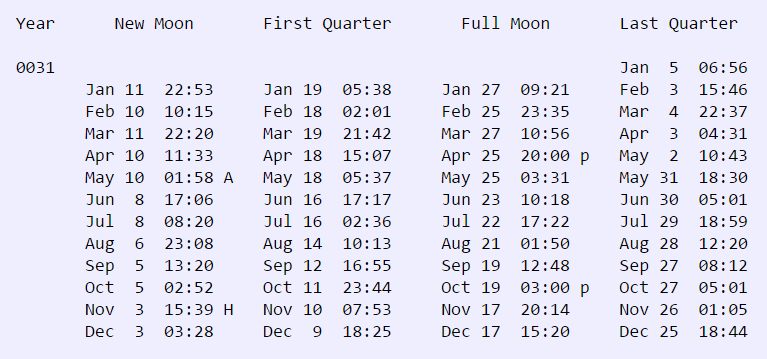
Source: http://astropixels.com/ephemeris/phasescat/phases0001.html
There are different schools of thought as to when a Biblical month and a Biblical Year commence. It is WLC's studied conviction that New Moon Day commences at dawn following the lunar-solar conjunction and the New Year commences with the New Moon closest to the vernal equinox.8 We will examine the year of the crucifixion from all angles and using all possible reckoning methods, though, to see if it is at all possible to have a "Friday Crucifixion."
First, we must note the time of the conjunction for both March and April in 31 AD, for the New Year could have begun in either of these months when all reckoning methods are equally considered.
Conjunction:
When reckoning New Moon Day (day one of the lunar month) as the day after conjunction, we find that Passover (the 14th day of the Lunar Month) would have fallen on March 25 (the equivalent of what the Gregorian calendar today calls "Sunday") or on April 24 (the equivalent of what the Gregorian calendar today calls "Tuesday"). You can view the 31 AD planetary weekday calendar6 here: http://www.timeanddate.com/calendar/?year=31&country=34
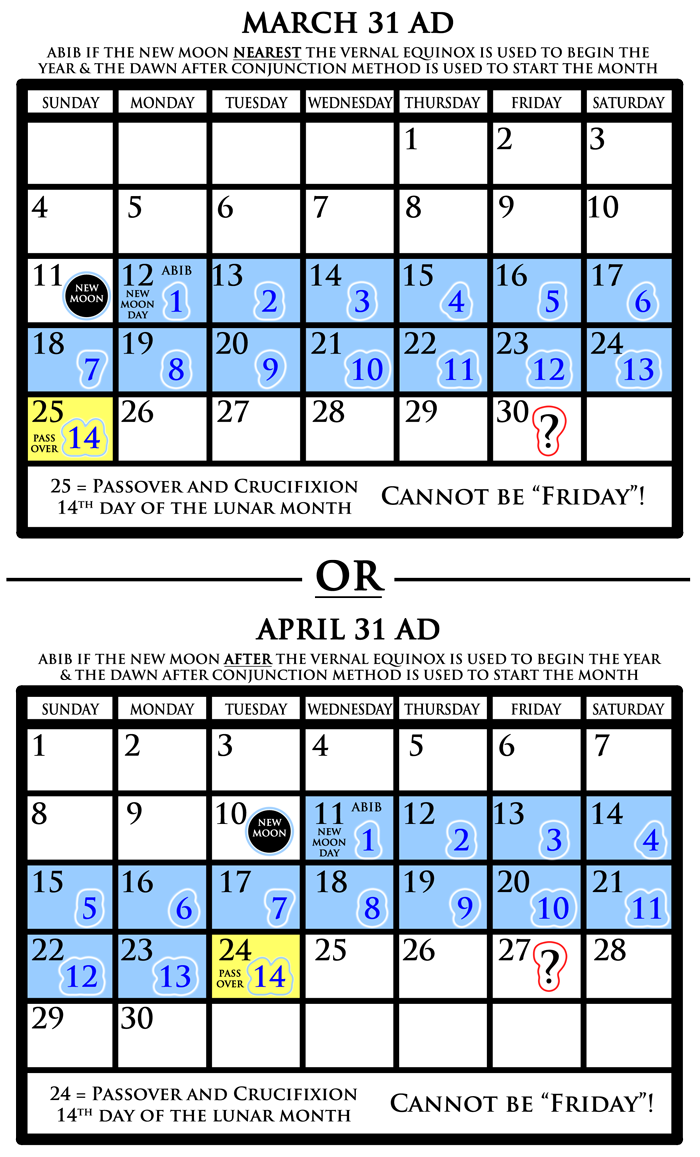
This does not even come close to a "Friday Crucifixion."
Now, let us try using the first visible crescent to begin the month, as many traditionalists advocate. According to scholars and astronomers, the earliest crescent generally becomes visible about 17-23 hours after the conjunction, while some have reported seeing it "as early as 15.5 hours after New Moon [conjunction]" (United States Naval Observatory).
"About 17-23 hours after the new moon [conjunction], a thin crescent becomes visible on earth." (http://www.moonsighting.com/faq_ms.html7)
"In 1855, Sir G. B. Airy prepared . . . astronomical calculations . . . relating to A.D. 29 to 34. . . . He considered that, especially in March and April and in the climate of Judaea, 18 hours after conjunction should suffice for visibility. But, as a precautionary measure, he calculated also for 23 hours." ("The Moon's visibility and the date of the Crucifixion," Courtenay R., The Observatory, Vol. 34, p. 228-232 (1911))
According to the Historical Research Committee of the General Conference of Seventh-Day Adventists, the first visible crescent becomes visible in the Near East less than 42 hours after conjunction:
"In the Near East it takes 16.5 to 42 hours after conjunction, depending on whether her movements in relation to her distance from the earth are fast or slow-before the moon becomes visible again in the form of a thin crescent, waxing larger and larger until the time of the full moon." (The Chronology Of Ezra 7, A Report of the Historical Research Committee Of the General Conference of Seventh-Day Adventists, p.11)
To recap, the earliest crescent:
That means that we should expect the first visible crescent to consistently appear 17-42 hours after conjunction in Jerusalem.
Now that we have clearly defined parameters for identifying the first visible crescent moon (i.e. 17-42 hours after conjunction), let us examine the month of March in 31 AD to see if it is possible to arrive at a "Friday Crucifixion" using the first visible crescent to begin the month.
Conjunction = March 11 @10:20 PM (UTC) = March 12 @12:20 AM (Jerusalem time, UTC+2). Below is the approximate time between conjunction and sunset of the given date. (Sunset in Jerusalem occurs around 5:45 PM in mid-March.)
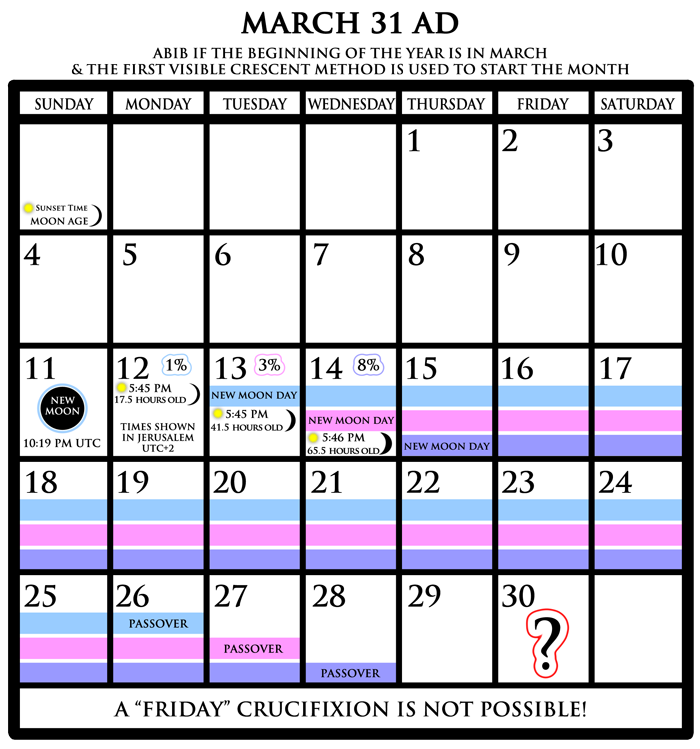
Clearly, it was not possible to have a "Friday Crucifixion" in the month of March in 31 AD. Now, let's examine the month of April to see if it is possible to arrive at a "Friday Crucifixion" using the first visible crescent to begin the month.
Conjunction = April 10 @11:33 AM (UTC) = April 10 @2:33 PM (Jerusalem - Daylight Saving Time, UTC+3 ). Below is the approximate time between conjunction and sunset of the given date. (Sunset in Jerusalem occurs around 7 PM in mid-April.)
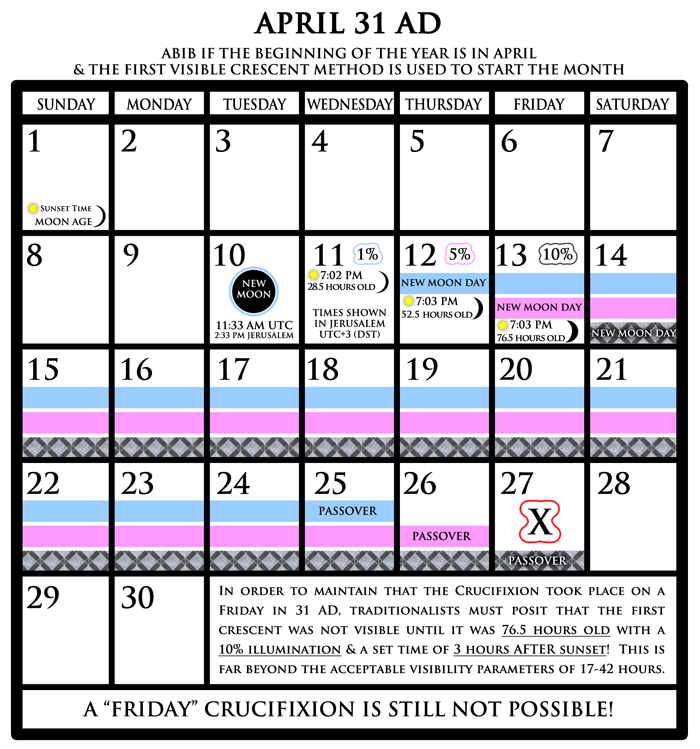
Here, again, we see that it is not possible to arrive at a "Friday Crucifixion." In order to maintain that the Crucifixion took place on a Friday in 31 AD, traditionalists must posit that the first crescent was not visible until it was 76.5 hours old with a 10% illumination! This is far beyond the acceptable parameters of 17-42 hours.
Remember, again, that the earliest crescent:
The moon would most likely have been spotted on April 11 when it was 28.5 hours old. If, however, it was not, it would surely have been seen on April 12 when it set about 2 hours after the sun at the age of 52.5 hours with 5% illumination.
To suggest that the moon was 76.5 hours old before it could be seen is simply not reasonable. Even if such an anomaly were possible, this assertion carries with it irreconcilable repercussions which undeniably attest to its absurdity:
Holding to a "Friday Crucifixion" in April of 31 AD would mean that for 5 consecutive months (February-June), the moon deviated far from the recognized parameters for establishing visibility (17-42 hours after conjunction). If one is to maintain that the Crucifixion happened on Friday, April 27 in 31 AD, they must believe that the youngest moon that could be seen between February and June of that year was 47.75 hours old.
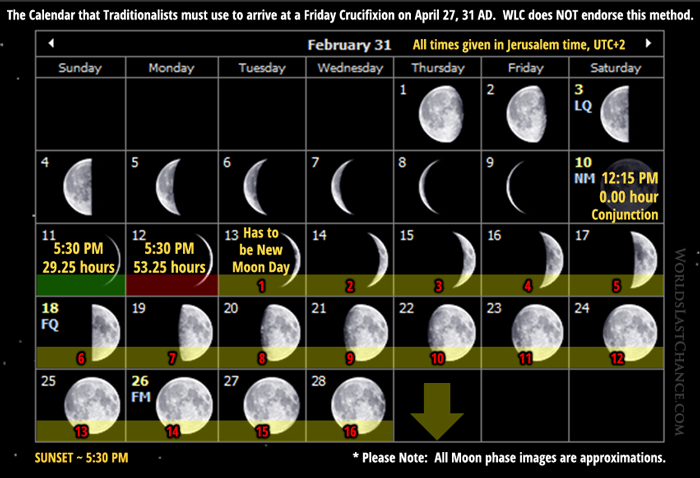 Conjunction = February 10 @12:15 PM (Jerusalem time, UTC+2)
Conjunction = February 10 @12:15 PM (Jerusalem time, UTC+2)Traditionalists who cling to a Friday, April 27 Crucifixion in 31 AD must accept February 13 as New Moon Day because a lunar month can never have more than 30 days. Counting backwards 30 days from New Moon Day in March brings us to February 13. This means that those adhering to this paradigm must believe that the moon could not be seen until February 12 when it was 53.25 hours old. (Note: This moon set about 2 hours after the sun with 6% illumination.) The moon most likely would have been visible on February 11 when it set about 1 hour after the sun at the age of 29.25 hours with 2% illumination.
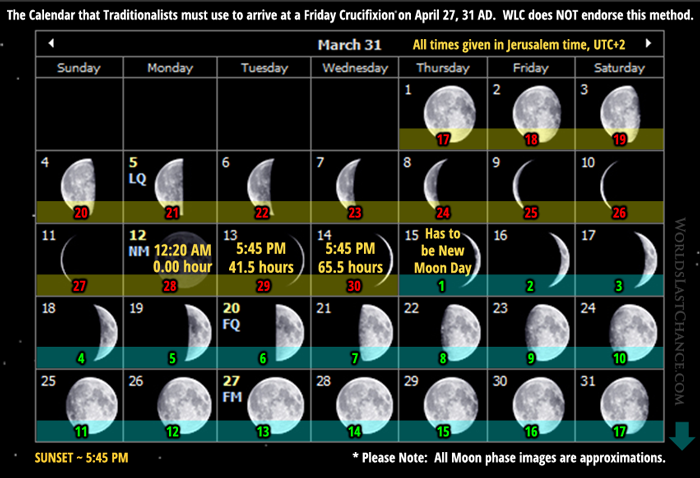 Conjunction = March 12 @12:20 AM (Jerusalem time, UTC+2)
Conjunction = March 12 @12:20 AM (Jerusalem time, UTC+2)Traditionalists who cling to a Friday, April 27 Crucifixion in 31 AD must accept March 15 as New Moon Day because a lunar month can never have more than 30 days. Counting backwards 30 days from New Moon Day in April brings us to March 15. This means that those adhering to this paradigm must believe that the moon could not be seen until March 14 when it was 65.5 hours old. (Note: This moon set about 2.5 hours after the sun with 8% illumination.) The moon would definitely have been visible on March 13 when it set about 1.5 hours after the sun at the age of 41.5 hours with 3% illumination.
 Conjunction = April 10 @2:33 PM (Jerusalem - Daylight Saving Time, UTC+3 ).
Conjunction = April 10 @2:33 PM (Jerusalem - Daylight Saving Time, UTC+3 ). Traditionalists who cling to a Friday, April 27 Crucifixion in 31 AD must accept April 14 as New Moon Day. This means that those adhering to this paradigm must believe that the moon could not be seen until April 13 when it was 76.5 hours old. (Note: This moon set about 3 hours after the sun with 10% illumination.) Again, the moon would most likely have been spotted on April 11 when it was 28.5 hours old. If, however, it was not, it would surely have been seen on April 12 when it set about 2 hours after the sun at the age of 52.5 hours with 5% illumination.
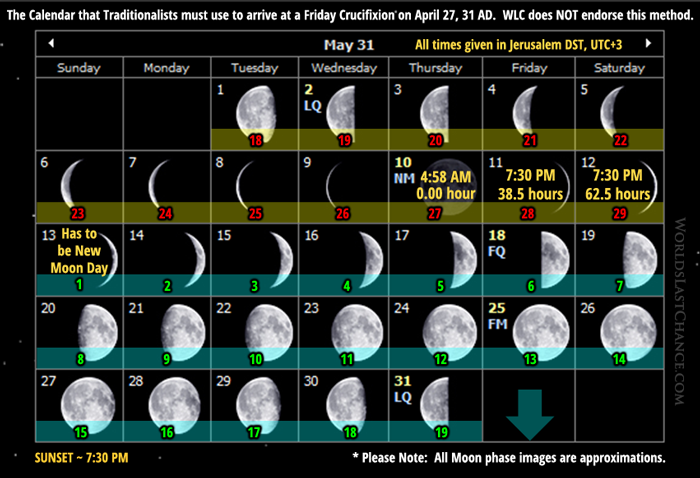 Conjunction = May 10 @4:58 AM (Jerusalem - Daylight Saving Time, UTC+3)
Conjunction = May 10 @4:58 AM (Jerusalem - Daylight Saving Time, UTC+3)Traditionalists who cling to a Friday, April 27 Crucifixion in 31 AD must accept May 13 as New Moon Day. This is the best case scenario for this paradigm because counting an extra day to make the previous lunation a 30-day month would demand embracing an even older moon as the first visible crescent. This means that those adhering to this paradigm must believe that the moon could not be seen until May 12 when it was 62.5 hours old. (Note: This moon set about 2.25 hours after the sun with 6% illumination.) The moon would definitely have been visible on May 11 when it set about 1.25 hours after the sun at the age of 38.5 hours with 2% illumination.
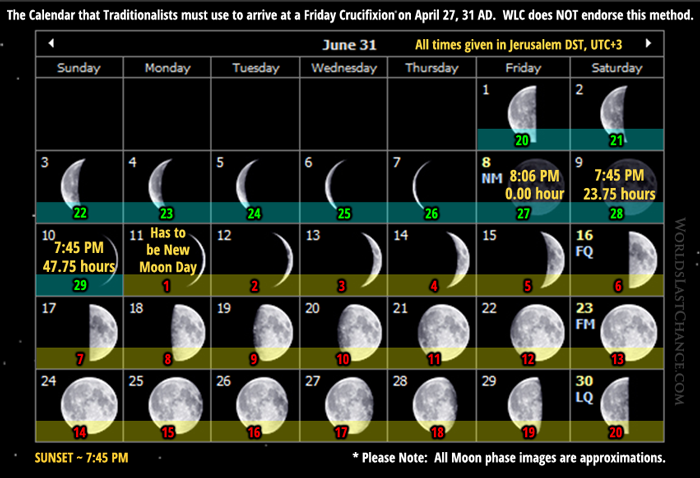 Conjunction = June 8 @8:06 PM (Jerusalem - Daylight Saving Time, UTC+3)
Conjunction = June 8 @8:06 PM (Jerusalem - Daylight Saving Time, UTC+3)Traditionalists who cling to a Friday, April 27 Crucifixion in 31 AD must accept June 11 as New Moon Day. This is the best case scenario for this paradigm because counting an extra day to make the previous lunation a 30-day month would demand embracing an even older moon as the first visible crescent. This means that those adhering to this paradigm must believe that the moon could not be seen until June 10 when it was 47.75 hours old. (Note: This moon set about 1.75 hours after the sun with 3% illumination.) The moon would likely have been visible on June 9 when it set about 45 minutes after the sun at the age of 23.75 hours with 1% illumination.
|
Adherents to the above model must believe that the youngest visible moon between February and June of 31 AD was 47.75 hours old. The ages of the earliest visible crescent that must be accepted, respectively, are: 53.25 hours, 65.5 hours, 76.5 hours, 62.5 hours, and 47.75 hours. Everyone of these, without exception, extends well beyond the established parameters for determining visibility.
Remember, again, the earliest crescent:
Note: The above model is the best possible scenario for those clinging to a "Friday Crucifixion" in 31 AD. To make even one adjustment to the number of days in these lunar months would necessitate accepting an even older moon as the first visible crescent. Everything must be counted from the immovable New Moon Day anchor point of April 14, for it is from this day that the 14th day of the the lunar month (Passover/Crucifixion) is counted. To change this day would result in day 14 of the lunar month not landing on a "Friday." Counting backwards from this point (April 14), you cannot number more than 30 days because lunar months never have more than 30 days. Counting forward from this point (April 14), you must count at least 29 days because lunar months never have less than 29 days. |
This means that in order to have a Friday, April 27 crucifixion in 31 AD, one must accept not only one anomaly (unexplainable irregularity), but 5 in a row! How can anyone, in good conscience, embrace such an outrageous proposition? Honesty demands that we follow the evidence wherever it may lead, even if it does not agree with our traditions and cherished presuppositions.
The fact that there could not have been a "Friday Crucifixion" in 31 AD has been confirmed by scholars across the board, including the late Sir Isaac Newton (the man esteemed by many as the "father of modern physics").
"He [Newton] thus excluded AD 31, 32 and 35 because 14 Nisan could not have been a Friday, which has been confirmed by all modern researchers." ("Newton's Date for the Crucifixion," Pratt, J. P., Quarterly Journal of the Royal Astronomical Society, Vol.32, NO. 3/SEP, P.301, 1991)
Scripture makes clear through Daniel's remarkable "70 weeks" prophecy that the Saviour was crucified in 31 AD. Scripture also makes clear that the crucifixion took place on the 6th day of the week, and on the 14th day of the first lunar month. When all of the calendrical details are brought together, it is incontrovertibly clear that the Israelites were using a different calendar than the world observes today. They were not using the Julian calendar, which was the precursor to the modern papal Gregorian calendar with its continuous weekly cycle.
Clinging to a "Friday Crucifixion" in 31 AD is not at all the result of honestly following the evidence to its logical conclusion. Rather, it is the consequence of cherishing tradition and obstinately rejecting the weight of evidence.
Many sincere Christians believe that Saturday is the Bible Sabbath for no other reason than it is the day observed by modern "Jews." While it is true that the Jews today worship on Saturday, this was not always the case. Jewish scholars are very clear that the original method of calendation was different from the modern calendar and that under intense Roman persecution during the fourth century A.D., the Jews gave up the original lunar-solar calendar.
"Under the reign of Constantius (337-362) the persecutions of the Jews reached such a height that . . . the computation of the calendar [was] forbidden under pain of severe punishment." ("Calendar,"The Jewish Encyclopedia)
"The New Moon is still, and the Sabbath originally was, dependent upon the lunar cycle." (Universal Jewish Encyclopedia, p. 410)
Those who teach that Saturday is the Sabbath base this belief exclusively on assumption and tradition. None can vindicate a Roman Gregorian Saturday Sabbath from Scripture alone. All who cling to Saturday are basing their practice upon the traditions of those who, as a nation, rejected the Messiah and the modern calendar promulgated by those who crucified Him.
Contrary to popular assumption, nowhere in Scripture does it say that the Sabbath is to be observed "every seven days." Rather, it says that the seventh-day Sabbath is to follow the six working days.
Remember the Sabbath day, to keep it holy. Six days shalt thou labour, and do all thy work: But the seventh day is the Sabbath of the Yahuwah thy Elohim. (See Exodus 20:8-10.)
See also: Ex. 16:26, 23:12, 31:15, 34:21, 35:2; Lev. 23:3; Deut. 5:13-14
It is only when a continuous weekly cycle is assumed that one concludes the Sabbath must fall every seven days. When Scripture is accepted for precisely what it says and all of the texts pertaining to the calendar and the feast days (including the Sabbath) are carefully studied, it becomes abundantly clear that the Biblical calendar is lunar-solar and is not at all synonymous with the modern papal Gregorian calendar and its precursor [the Julian calendar].
In Scripture, each lunation starts with the celebration of a special day of worship: New Moon Day.10 Six work days follow and then a seventh-day Sabbath on the eighth of the month. Three more weeks follow, ending on the 29th. The weekly cycle then restarts following the next New Moon Day. (No month ever has more than 30 days.)
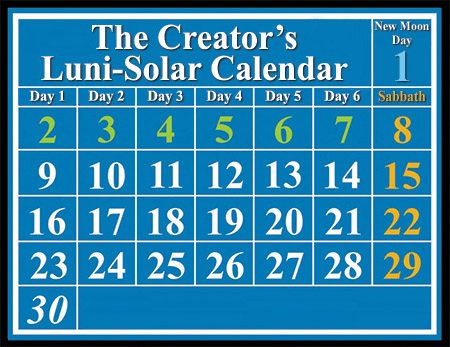
Every time a seventh-day Sabbath in Scripture is assigned a date,
it always falls on the 8th, 15th, 22nd and 29th days of the month.
Originally, all ancient calendars were luni-solar with the weekly cycle (of varying lengths) restarting every new moon. Chronologists date the first calendar with a continuous weekly cycle to Babylon around 600 BC. Prior to that time, no calendar utilized a weekly cycle that had no interruption. The weekly cycle restarted either at the beginning of the month/lunation or at the beginning of the year following five intercalated days that closed the previous year but were not part of any weekly cycle.11
|
"We implore you, beloved of Yahuwah, not to take our word for it. Please investigate these things for yourselves. Many objections to the lunar Sabbath, that on the surface seem valid, fail miserably under close examination." |
The fact is that the modern papal Gregorian Saturday Sabbath cannot be substantiated by Scripture or calendar history.12 The erroneous doctrine of a continuous weekly cycle is established on nothing more than assumption. It is high time that Yahuwah's faithful step free of this deception make Scripture alone the rule of faith and practice.
We implore you, beloved of Yahuwah, not to take our word for it. Please investigate these things for yourselves. Many objections to the lunar Sabbath, that on the surface seem valid, fail miserably under close examination.
We implore you to dig deep into this issue with an honest heart.
Click here for a list of articles and videos on the Lunar Sabbath.
Click here for a list of articles and videos on the Biblical Calendar.
 |
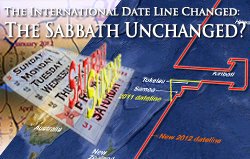 |
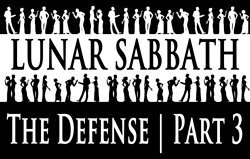 |
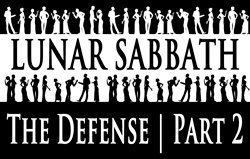 |
All quoted Scripture is taken from the NKJV unless otherwise noted.
1 Sadly, it is this remarkable prophecy that many grossly misinterpret in order to arrive at the increasingly popular yet unbiblical notion that in the near future, a mysterious "antichrist" will arise and sign a 7-year peace treaty with the nation of Israel. For more on this important topic, see Seven Year Tribulation (Q&A) and "The Secret Rapture: Satan’s Secret Weapon."
2 n/a
3 The accession year of Artaxerxes I was 465-464 BC; his first regnal year stretched from the autumn of 464 BC to the autumn of 463 BC. We know that the "going forth" of Artaxerxes' decree was in 457 BC because Ezra tells us that he departed Babylon in the spring, in the first [Biblical] month, and arrived in Jerusalem in the fifth [Biblical] month of Artaxerxes' seventh year. "And he [Ezra] came to Jerusalem in the fifth month, which was in the seventh year of the king. For upon the first day of the first month began he to go up from Babylon, and on the first day of the fifth month came he to Jerusalem, according to the good hand of his Elohim was upon him." (Ezra 7:8-9)
4 http://en.wikipedia.org/wiki/Tiberius
5 Using the Biblical lunar-solar calendar established at Creation, this is never an issue. The Pharisees who penned the Talmud had to create special rules for dealing with these types of situations, none of which can be supported by Scripture. http://www.truthontheweb.org/postpone.htm (Note: WLC in no way endorses the teachings found on this site. The link provided, however, illustrates well the multitudinous postponement rules created by those who rejected both the Messiah and Heaven's calendar.)
6 Rome, at the time of Christ, was not observing the 7-day planetary week observed by the world today. Rather, they were observing the 8-day cycle of the Julian calendar:
7 http://www.moonsighting.com/faq_ms.html - WLC in no way supports the doctrines espoused by this site, as it is affiliated with the teachings of Islam. None can argue, however, that those practicing Islam, while deceived, are very serious and very diligent in their study of the moon and its earliest visibility following conjunction, for it is by this observation that they begin their months.
8 By WLC's method of reckoning, Passover would have fallen on March 25 in 31 AD.
9 The listed rise/set times of the moon, as well as the percentage of illumination are confirmed by Starry Night Pro, Quick Phase Pro, and Stellarium software. You can download Stellarium for free at the following link: http://www.stellarium.org/
10 The importance of New Moon can be seen in the fact that the sacrifices prescribed for New Moons were considerably more than those prescribed for the weekly seventh-day Sabbath. (Numbers 28:11-15)
11 Eviatar Zerubavel, The Seven Day Circle, pp. 7-8.
12 • Continuous Weekly Cycle Proven False
• 8 Days a Week? Julian Calendar History (>>Video)
• The Modern Seven Day Week: Exploring the History of a Lie
• International Date Line Change: The Sabbath Unchanged? (>>Video)
• Catholic Scholar Verifies Neither Saturday nor Sunday is Biblical Sabbath